Month 6:22, Week 3:7 (Shibi'i/Sukkot), Year:Day 5942:169 AM
2Exodus 5/40
Gregorian Calendar: Sunday 2 September 2018
The Earliest Vision
The First Believers & the Resurrection
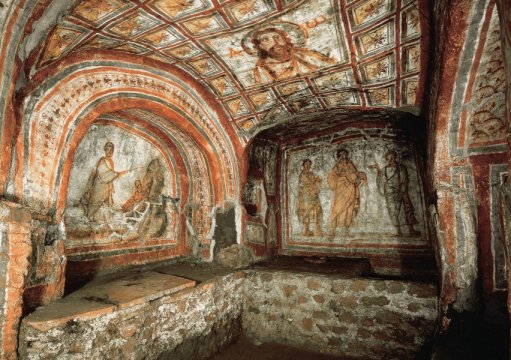
Introduction
Shabbat shalom kol beit Yisra'el and Mishpachah. It is good to be back. I am sorry I missed you last week as I was unavoidable detained by illness though the sermon was subsequently published and recorded (#V036). I have been very busy on numerous materials, of which last week's sermon was a part, and they are about 90 per cent done. What I have been trying to do is combine deep theological studies with overviews in the vernacular so that both the layman and scholar amongst you can be equally blessed. I am - and always have been - deeply concerned that we, as a people, be bearers of an accurate message because the way our minds are formed will also shape the way our hearts respond. So this has been both a hard slog - and it really has been tough at times - but also enormously rewarding.
The Task of the Minister
The task of a minister, preacher, teacher and pastor is to preach the saving Besorah (Gospel) and to disciple converts into the Messianic Israelite way of life. All believers are doing both these tasks to differing degrees. As a community, Messianic Evangelicals have a 31-year history, which is but a tiny speck in terms of the 2,000 years that have elapsed since the Saviour was born. And so much has happened, there has been so much change, not all of it for the good.
Seminaries, Theological Colleges and Early Believers
If any of you listening to me have ever been to a theological training school you will have had a version of Church history taught to you that accords with the evolution and expectations of the denomination that runs it. Now I am not saying that seminaries and theological colleges are unimportant, because they are, provided you are open to alternative viewpoints and don't allow yourself to get stuck in one denominational rut of thinking. For if there is one thing that has been made clear to me over the past three decades, it is that the early believers were very different in their thinking and approach to the Gospel life than the vast majority of those who call themselves 'Christians' or 'Messianics' today.
What Were the First Believers Like?
So I am a great admirer of, and have tremendous respect for, historians who are both honest and rigorous like N.T.Wright and Ben Witherington. What were the first believers like? What was uppermost in their minds? What were the theological controversies, and therefore heresies, of the first few centuries since the coming of Yah'shua (Jesus)?
A Different Set of Priorities
They were suprisingly uncomplicated in their beliefs. Afterall, none of the theological controversies that have troubled Christendom since the Reformation, for example, were ever dreamed by them. Now I could make a huge list of the things which modern believers believe which they didn't believe like Calvinism, Pre-Tribulation Rapture, KJV-Onlyism, and Tongue-Speaking, but that would be counter-productive. What I want to do today is look at the believers of the first couple of centuries in particular, and get into their heads, hearts and lives. I want to know what their emunah (faith) was based on with a view to finding out whether or not we have wandered off the path.
The Threat From Within
The Messianic Community (Church) faces its greatest dangers not from without - the hosility of those who do not like the Besorah (Gospel) disturbing their pagan or hedonistic ways of life - but from within, and not in a way you might immediately suspect. As converts from pagan philosophy came to Messiah in the early centuries, they brought their old heathen doctrines with them and mixed them in with Christianity. And according to the historical experts, from as early as the second generation of believers, they soon departed from the simplicity of the apostolic community and corrupted the purity of the Christian/Messianic emunah (faith).
Preserving the Simplicity
This has, moreover, happened in every generation over the last two thousand years. And the modern churches and messianic assemblies are no different - they are full of compromised doctrines and practices. And one of the toughest jobs that the nevi'im (prophets) have to do in every generation - and not always successfully, I might add - is to preserve the simplicity by exposing and expelling the false thinking from the unbelieving world that comes into congregations on the backs of converts.
The Problem of Operating in the World System
The Messianic Community's (Church's) greatest danger in any age is that is comes to reflect the age in which it lives by a process of reverse osmosis. It's a bit like a pot of honey around which thousands of flies swarm. Then the question becomes: how do we keep the Messianic Community (Church) pure? How do we prevent contamination from the corruption of the outside world? One solution is to isolate it...but that is not what the Community was created for. As believers we are given the seemingly impossible talk if being in the world system whilst resisting being of it. The Scriptures are full of admonitions such as this one:
"Do not love the world or anything in the world. If anyone loves the world, the ahavah (love) of the Father is not in him. For everything in the world - the cravings of sinful man, the lust of his eyes and the boasting of what he has and does - comes not from the Father but from the world. The world and its desires pass away, but the man who does the will of Elohim (God) remains for the aeon" (1 John 2:15-17, NIV/CLNT).
Contamination Within and Without
The risks are obvious but it is necessary to take them. We're supposed to be around people in the world so we can witness to them, but we aren't supposed to ever be comfortable in it or, worst of all, get so comfortable as to make it our home. And the more risk there is, the greater the chance of making mistakes and becoming contaminated. There is therefore a lot of spiritual work to be done, on a daily basis, in order to remain clean before Yahweh, until it becomes second nature. And these days you don't even have to go outside your home to get contaminated. Television, radio and the internet can flood the Christian/Messianic home unless you carefully regulate it. And that, inevitably, requires a lot of self-discipline. If you are too weak, then you are instructed by Yah'shua (Jesus) to take drastic action and cut off the source of temptation until you have mastered your flesh. That in itself is the overcomer's ongoing battle, so the sooner you start the battle with a view to winning, the better. Of course, the more surrendered you are to Messiah, the easier it becomes, because a surrendered soul is no longer drawn to the temptations of the world.
Death, Rest and a New Life
One thing that particularly fascinates me about the early believers was their view of life, a view that was so radically different from the paganism they lived amongst and which made them stick out like sore thumbs. They did not blend in with the world at all! Moreover, they had a hope and a confidence unlike anything the pagans enjoyed. And as I have showed clearly in the materials I have been publishing on the afterlife, they had no concept of eternal hell (so they were not terrorised by that doctrine) and almost never spoke of 'heaven' as their final destination either. They expressed their hope in the simplest of terms - they believed that after death, there would be a period of rest and then a new life, a new embodiment or tabernacling which they called the resurrection.
Kipling's Poetic Perception
The Britsh poet, Rudyard Kipling, captures that early essence in a piece written in 1892:
"When Earth's last picture is painted and the tubes are twisted and dried,
When the oldest colours have faded, and the youngest critic has died,
We shall rest, and, faith, we shall need it - lie down for an aeon or two,
Till the Master of All Good Workmanship shall put us to work anew.
"And those that were good shall be happy: they shall sit in a golden chair;
They shall splash at a ten-league canvas with brushes of comets' hair.
They shall find real saints to draw from - Magdalene, Peter, and Paul;
They shall work for an age at a sitting and never be tired at all!
"And only the Master shall praise us, and only the Master shall blame,
And no one shall work for money, and no one shall work for fame,
But each for the joy of the working, and each, in his separate star,
Shall draw the thing as he sees It for the God of Things as they are!" [1]
The Shelley Memorial
In University College, Oxford, where I was a student in the 1970's, there is a famous memorial to the atheist Shelley, a rather ugly one, in my view, depicting his body after committing suicide. His poetry was embued with those romantic Neoplatonic pagan ideas ideas about the afterlife which so early on infected the Roman Church which parented the Protestantism he grew up in. He believed in the pantheistic notion that the soul would be transformed into part of the beauty of the universe, a picture still faithfully reproduced in many Anglican funeral services even today.
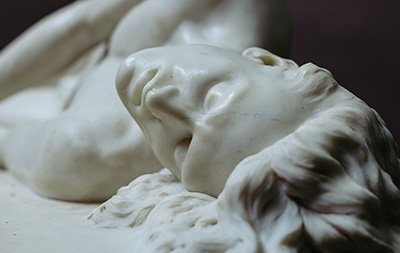 The Shelley Memorial, University College, Oxford
The Shelley Memorial, University College, Oxford
The Church's Reversion to Paganism
Once infected with paganism, the Church gradually, but at an ever quickening pace, particularly since the 20th century, has more and more reverted back to the pagan influences which it early on married to the Besorah (Gospel), ideas which hearken back to Rome and Athens. So it is of particular interest to me that one of the most detailed and endearing pictures we have of early Christianity and what it believed comes, not from Jerusalem, but from the Roman catacombs. More about that later, if we have the time.
Spanning History
I think, in order to grasp the full scope of eccelsiastical history, you need to be something of an eclectic. That means sifting through vast amounts of data from different sources and perspectives - from the first Hebrew believers, then the Greek, Latins and finally the Germans, Dutch and British who brought about, and formulated the theology of the Reformation.
Offending the Purveyors of Torture and Annihilation
Many, if not most, of the earliest beliefs of the Hebrews and Greeks in particular, are deeply offensive to Western sensibilities. Challenge the doctrine of 'eternal punishment', for instance, and you will enrage the ecclesiastical establishment which finds it so comfortable, but the alternative would appear to be complete annihilation - or 'annihilationism' - popularised by the Jehovah's Witnesses and now being increasingly embraced by Messianics. These two schools of thought concerning the next life hate each others' guts. Perhaps Dylan Thomas, the Welsh Poet, best captures the sentiment of the annihilationists who, at the death of his father, angrily retorted:
"Do not go gentle into that good night.
Rage, rage, against the dying of the light." [2]
The Rise of Annihilationism
That is a depressing doctrine, and as horrific, in another way, as the dark fantasies of the proponents of eternal torment. Yet I believe this doctrine will find greater and greater acceptance in the years to come as the world becomes ever more pessimistic and nihilistic. Thomas and Shelly have, alas, a lot in common, with Shelley's narcissism atheism being more akin to a modern New Age nature religion:
"Do not stand at my grave and weep,
I am not there, I do not sleep.
I am a thousand winds that blow,
I am the diamond glints on snow.
I am the sunlight on ripened grain,
I am the gentle autumn rain...
Do not stand at my grave and cry,
I am not there. I do not die."
The Downgrading of the Physical
We shall not dwell further on those who had no hope either because either they had no faith in the biblical Messiah or because they had subscribed to a false picture of the afterlife. The Platonists, sadly, like the Gnostics, downgraded physical bodies and the created order, viewing them as 'vain shadows'. Not so the first believers. For them, as for us, the future physical resurrection was a motive for treating our bodies properly in this life:
"By His power Elohim (God) raised the Master [Yah'shua/Jesus} from the dead, and He will raise us also" (1 Cor.6:14, NIV).
Training for the Future Life
And the apostles used this future hope, every bit as physical as spiritual, to encourage us to work hard in the present as training for the life to come in future aeons:
"Therefore, my dear brothers, stand firm. Let nothing move you. Always give yourselves fully to the work of the Master because you know that your labour in the Master is not in vain" (1 Cor.15:58, NIV).
Our Heavenly Memorials
Everything we do for Yah'shua (Jesus) counts and is not lost. Nothing done with a pure heart in this physical realm is wasted. Indeed, it is my belief that everything we create here in matter is created in parallel in the spiritual domain. Yahweh keeps, as it were, a three dimensional spiritual printout of everything we have built for Him. And so, even though great works of art created to glorify Yahweh in the past have since been destroyed by war or neglect, I believe they exist in the spiritual domain, and will serve as templates for a future reconstruction in the resurrection worlds to come. Entropy will not have the final word on the fate of the creations of Yahweh's servants in mortality. And not just visible physical things, of course, but invisible yet audible things like music and poetry too. He does not forget. He memorialises every good thing and uses it to decorate His courts.
The Bible Was Not Central to the First Believers
The focus - or a major focus - of Evangelical Christians today is the Bible - or the Torah for Messianics. But, important though the Scriptures were for the believers of the first few centuries, it was not the major thing. What mattered the most to them was something else. And remember, the New Testament canon did not come into existence until the Council of Carthage in AD 300 - the 'Bible', for the first believers, was the Tanakh or Old Testament.
Not Miracles, Nor the Supernatural, Not Yah'shua was Alive
So what was the most important thing to them? Was it 'miracles'? No, they were not like modern charismatics, even though they absolutely believed in, and experienced, divine miracles like healing. Was it the 'supernatural'? No, even though belief in the supernatural was a way of life, much as it still is for most Africans. They were not like today's Sid Roth with his It's Supernatural TV program. The issue for the ancient Christians was not that 'Yah'shua or Jesus is alive today and we can get to know Him personally' either, it may surprise you to learn also, even though, of course, they totally believed that He was alive and that He could be known personally.
The Physical Resurrection Was Supreme!
The overwhelming focus of the first believers, beyond any historical dispute, was that the physical Messiah, Yah'shua (Jesus), had risen from the dead and was forevermore alive! And why did this astonishing resurrection event stick out so prominently? Because, with the exception of the Hebrews, nobody in the ancient world believed that the dead could, or ever would, rise again! And the Hebrews, and most particularly the Pharisee party who were the champions of resurrection, did not believe that anyone had done so, or that anyone would do so all by themselves in advance of the resurrection. And I would like to suggest that 2,000 years later, that little has substantially changed, except in place of - or at least, in addition to - the pagan religions, the 21st century world of sceptical atheism still does not believe that anyone could ever rise from the dead, even if they're trying to freeze people with the hope of restoring them one day when technology has advanced. In that respect, little has changed...except most modern believers now no longer, generally, emphasise the resurrection as the first believers did, or deny it outright, viewing it in symbolic terms only.
The Message That Galvanised the World
This is the first point I want to to make about early Christian emunah (faith) and proclamation - because this was the central tenet that dominated their evangelism, and it was this central emet (truth) that galvanised the world. But there was more, of course.
Resting Before the Resurrection
To begin with, their overarching Message was that since Yah'shua (Jesus) had arisen from the dead - physically - that what had happened to the One would happen to everybody else! Further, what they were not saying was that Yah'shua (Jesus) was in Heaven now and therefore that that was the place that everyone could look forward to. In their minds, heaven was very much second place, rather as hôtel accommodation while you're on holiday is not your main domicile, but a temporary one until you get back home after your vacation. And that is so important to understand, for as I have told you before, and as recently as last month, the original word for the "mansions" that Yah'shua (Jesus) told His talmidim (disciples) He was going to prepare for them was not some palacial final destination but a traveller's inn. So when the first believers spoke of 'resting' before the glorious resurrection back on earth, it was 'heaven' they were speaking of. Heaven was, for them, like the hôtel in my illustration, a temporary spa until the major happening of the resurrection and relocation back down here on earth.
Getting a Right Emphasis
It's the emphasis that's the important thing here. Believers these days emphasise all sorts of different things and can quickly lose track of what's most important. For modern Christians, 'heaven' (unless you're an advocate of soul-sleeping) is the main destination with 'resurrection' somehow fitting into all of that. For the first believers heaven was a short vacation before the main event - homecoming to this world.
Early Views of the Resurrection
Now the early pre-Messianic Israelites knew all about the resurrection. They understood that the end of this life would be followed by restoration back on the earth. Just what the resurrection would look like, they didn't really know, but they erroneously assumed that we would be pretty much as we are now. And their understanding of the 'intermediate state' was poorly developed. They knew of Sheol, the Underworld, and they knew it was divided into two parts, Paradise and Prison, though really they knew almost nothing about them until Yah'shua (Jesus) and the apostles fleshed the emet (truth) about these in what became modern revelation.
The Apparent Finality of Death
Looking for a blueprint of 'heaven' in the Tanakh (Old Testament) is not a realistic proposition, though many have tried, because it simply isn't there. And because of the sparsity of information, and the poetic language for dying used ('sleeping'), modern exegetes have (wrongly) concluded that death was a complete cessation of existence. The only reference point of the ancients was life on earth and so, from that perspective, death looked very final indeed.
Viewing Death Like the Ancients
Indeed, does it not also appear that way to us when a loved one dies here? As the years pass, and the memory dims, we don't think too much of them being alive again, except in the vary vaguest terms in the way distant future. Time has that effect on human beings. And so when Yah'shua (Jesus) died on the cross, then to the talmidim (disciples) that was it - it was all over - and they went back home, dejected and discouraged. Yet their response was really no different from that of the general culture of the day which, though it believed in a far-off day of resurrection in the very vaguest of terms, pretty much viewed death as finito - the End.
What Galvanised the First Believers
That's why Yah'shua's (Jesus') resurrection was such a shock to them. They weren't expecting it even though he had hinted at it so many times. That's why they were so galvanised. That's why the physical resurrection became the pre-eminent Doctrine of the Faith to be proclaimed loudly to the whole world! I mean, there were people alive who had been witnesses, and that must have been a powerful testimony to hear! We don't have that advatnage, even if we do have their written testimonies. The inner transformation of souls by the resurrected Messiah moves us far more, understandably.
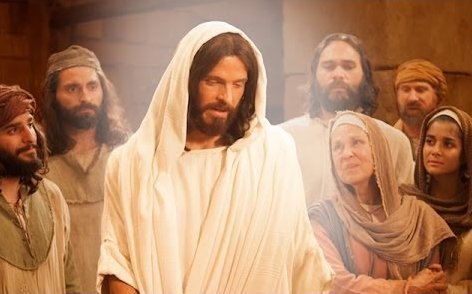 The driving force behind the first believers was the resurrection of Messiah
The driving force behind the first believers was the resurrection of Messiah
Do Resurrected People Shine?
Now when you ask people to describe what they think resurrection looks like, many have the idea that it looks something like the Transfiguration (Mt.17:1-9), when the 'dead' Elijah and Moses appeared together with an illuminated Yah'shua (Jesus) on a mountain in the presence of the chief apostles or presiding patriarchs of the Messianic Community (Church) - Peter, James and John - the 'inner circle'. Certainly, resurrection is very glorious indeed. But the resurrected Messiah was not shining like an incandescent lamp when Mary stumbled on Him ín the Garden of Gethsemane, mistaking Him for the gardner. He wasn't glowing or shining brightly. He was different, in some way, which is why Mary initially failed to recognise Him. He was very physical indeed, quite solid, even though this new body of His had supernatural properties enabling it to pass through solid objects like doors and walls in this planetary sphere.
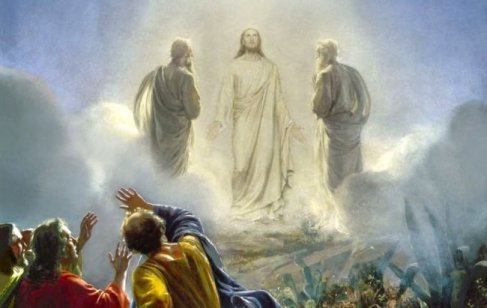 The transfiguration of Yah'shua and appearance of Moses and Elijah
The transfiguration of Yah'shua and appearance of Moses and Elijah
What Resurrected People Actually Look Like
The important thing I want to convey to you about this resurrected body, the same belief the first talmidim (disciples) held, was that though a resurrected body appears slightly differently to the mortal one, and though it is immortal - indestructible and undamageable - it was basically of the same basic 'stuff' as mortal human beings. A resurrected person would easily pass off as a mortal person on earth, blend in with the crown, and draw no special attention to himself except he would not be subject to injury, disease, or death.
Does Resurrected Flesh Have a Glory?
Why did Yah'shua (Jesus) shine so brightly on the Mount of Transfiguration? Well, it wasn't because of his physical immortality, because He wasn't yet resurrected. He shone because His glory as Deity was being revealed. Is there a glory to a resuurection body? Most definitely, and there are three distinct types of resurrection glory, as Paul explained to the Corinthians, but those possessing this glory must presumably have the ability to conceal it at will. That's my guess but it seems a reasonable postulate in light of the evidence.
Adjusting Worldviews
Now, it's true, there were all sorts of different ideas about life-after-death and resurrection in Yah'shua's (Jesus') day, just as there are all sorts of views about almost every gospel topic you can think of today, because it is human nature to speculate. Judeans and pagans converting to the Besorah (Gospel) would therefore have had to make some major world-view adjustments, those from the pagan world having to make the biggest adjustments of the two, obviously.
The Cosmopolitan Cultural Melting Pot of Corinth
The Corinthians, to whom Paul wrote about the two resurrections and the three glories, was speaking to a very muddled (not to mention immature and trouble-making) group of cosmopolitan ex-pagan gentiles with no, or little, exposure to Judean cultural thinking. And cosmopolitans - those from cities - tend to be immersed in all kinds of religious, philosophical and atheistic ideas, cities being the melting pots of the entire gammut of human thinking, then as today. I suppose you could say I was fortunate to have been living in Oxford in the days of my searching for emet (truth) because in that city of scholars and visitors from all over the world, you could find virtually every system of thought and religion that existed. And I have no doubt that is how Yahweh ordained it to be for me, because of what I have been called to do.
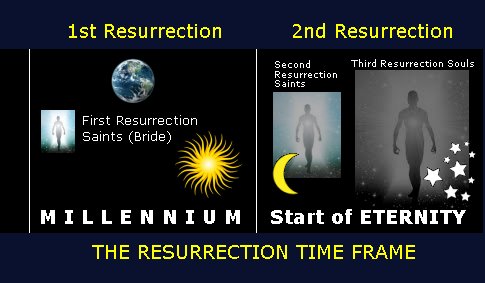
A United Resurrection Doctrine in the Beginning
Nevertheless, in spite of all these converts coming from a diverse spectrum of belief systems, there never was more than one doctrine about the resurrection in the early Messianic Community (Church). They were all of one mind in that respect because speculation wasn't needed. There were living witnesses. It wasn't until the late 2nd century, over 150 years after Yah'shua's (Jesus's) ascension, that other definitions and ideas about 'resurrection' started appearing as the Adversary set about trying to cause confusion, as he has done, and continues to do, in everything.
Shifting Away From Earth to Heaven
It wasn't until then, and later, that the emphasis shifted away from resurrected life here on earth to a more 'spiritual' idea about heaven being the place on which to set ones hopes as a disembodied entity. Thus, if I can use an analogy, a new emphasis arose in which it was stressed that what was important was soaking in a hot bath tub, having first disrobed, when in truth the important thing was what comes after the bath (pleasant rest) and clothing in a resurrected body. The naked tub-soak will be wonderful to be sure, but it isn't the main event. And just as sitting too long in a tub can cause the skin to wrinkle, so focussing on heaven instead of the resurrection life has the tendency to wrinkle or warp the mind and therefore spiritual life too.
A Harmful Regression
That was the first major mutation of the Besorah (Gospel). The resurrection, having been peripheral in the Second Temple period (as we see in 2 Maccabees 7), was suddenly thrust into the centre by the resurrection of the Son of Elohim (God). And so what we see is a regression of sorts as once again the resurrection came to be de-emphasised by later generations.
The Lyons Riots
You see, the Resurrection Message provoked the pagans to fury, because Satan hates that message. He would rather you talked about the disembodied state as the 'main thing', because that's what pagans talk about too. They have no issue with disembodied spirits, ascended masters, reincarnation, and the like. Indeed, the pagans became so infuriated with Christians in AD 177 Lyons (what is now France) that they started butchering them, including the Bishop or Overseer of Lyons. The point of contention was the physical resurrection with which they could not compete.
The Transformative Power of Resurrection Life
Why is the resurrection story so important? Well, aside from the obvious one, which is the hope of aeonian (age-abiding) life leading to immortality, resurrection is all about the here and now because the resurrection is primarily about SUPERNATURAL TRANSFORMATION, and not just of the physical body - it's also about the transformation of the mind, heart and spirit - the inner man.
The Acquisition of New Properties
Resurrection chayim (life) isn't just about the the flesh - it's also about the transformation of character. And just as physical matter in the resurrection acquires new properties, so the inner life of man acquires new properties when it is touched by resurrection chayim (life). The change in the physical that is to come provides the clue as to how we are to understand the progressive change of the inner man in the here and now. The first believers knew that these went hand-in-hand. And both of these bodies - the physical (to be instantly transformed in the future at the blast of the silver trumpets at Yom Teruah, which we shall be observing in just over a week's time), and the inner body, are both described by the apostle Paul as "spiritual".
Two Kinds of Body Explained
1 Corinthians 15 is one of those great chapters about the resurrection. I would encourage you to read it through after the assembly this morning as it's a little too long to read out here now. I draw your attention to it because a major error is made here by some believers. In it, the apostle Paul speaks of two kinds of body, the present one and a future one. Pauline scholar N.T.Wright explains:
"He uses two key adjectives to describe these two bodies. Unfortunately, many translations have got him radically wrong at this point, leading to the widespread supposition that for Paul the new body would be a 'spiritual' body in the sense of a 'non-material' body which in Yah'shua's (Jesus') case wouldn't have left an empty tomb behind it. It can be demonstrated in great detail, philologically and exegetically, that this is precisely not what Paul meant. The contrast he is making is not between what we would mean by a present 'physical' body and what we would mean by a future 'spiritual' one, but between a present body animated by the normal human soul (sic. - he means 'spirit'), but between a present body animated by the normal human soul (sic.) and a future body animated by Elohim's (God's) spirit" [3].
The Resurrection Superglue
The point being, the future resurrected body will be incorruptible. It will itself be animated by Yahweh's Ruach (Spirit) which for now only dwells in our mortal physical body along with our own spirit, like a hand in a glove. Of course, the Ruach (Spirit) in us affects our physical body but not in the same way as in the resurrection. Then - at that time - the Ruach (Spirit) will act rather like Superglue, permanently bonding physical matter and spirit together as one indivisible substance, so that death - the separation of spirit from the fallen physical body - will then become impossible. Our present flesh - physical body - is corruptible, a reason why we cannot now physically eat of the Tree of Life, and why Adam and Eve were debarred from doing so after they had fallen, so that they would not become immortal in sin.
All Are Resurrected Before the Judgment of Mankind
Paul said, in that important 15th chapter of 1 Corinthians, that "flesh and blood cannot inherit the kingdom of Elohim (God); nor does corruption inherit incorruption" (1 Cor.15:50, NKJV). That is why the physical body has to be completely transformed, and that is what the resurrection power of Yah'shua (Jesus) will one day do. That means, incidentally, that since everyone is resurrected prior to the Final Judgment - both the "just" and "unjust" (Ac.24:15) - that the wicked cannot be annihilated, as Annihilationists insist, putting the lie to that particular doctrine.
Platonists, Adventists and Gnostics
This 15th Chapter in 1 Corinthians is all about the 'New Creation' that the resurrection brings about, not just of men spiritually now, and of men physically in the future, but of the entire planet and cosmos. This is a monumentous, epic transformation, and on a scale we cannot possibly fathom. Yahweh does not abandon the planet as the Platonists taught, Seventh Day Adentists teach today and Gnostics in general believe, but He remakes it. You see, Yahweh is not wasteful. Whatever men and demons mess up, Yahweh restores through resurrection power. And yes, He restores all human beings - He does not abandon them to eternal torment or to annihilation. He saves everyone but not in the same way or to the same glory.
The Righteous Will Shine Like the Sun
Speaking of those believers who are the Bride and of the First Resurrection, Yah'shua (Jesus) said:
"Then the righteous will shine like the sun in the kingdom of their Father. He who has ears, let him hear" (Matt.13:43, NIV).
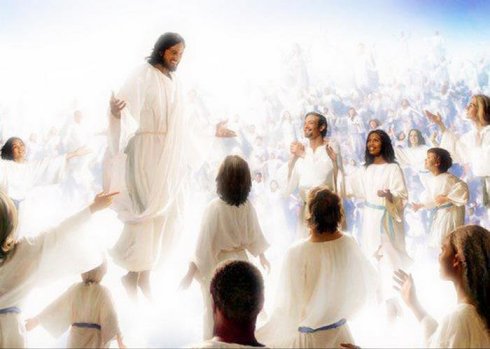 The shining of the righteous qodeshim
The shining of the righteous qodeshim
The Three Resurrection Glories
Now whilst this could well be a description of luminosity or a literal, physical shining (like that of the Messiah at the Transfiguration), this is, as scholars point out, just as likely to be a description of the status of these believers. Where have we come across this type of status category when it comes to the resurrection? Yes, Paul's own words to the Corinthians again, who aparrently needed this matter clarifying as they were not getting something that was apparently udnerstood by all the other congregations where Paul does not feel the need to say this again:
"There is one glory of the sun, another glory of the moon, and another glory of the stars; for one star differs from another star in glory. So also is the resurrection of the dead" (1 Cor.15:41-42, NKJV).
Three Different Statuses Before Elohim
In other words, the dead are all raised to different glories, shinings or statuses. Yah'shua (Jesus), as we saw, makes mention of this 'shining' in Matthew 13:43 where He speaks of the status of those belonging to the Kingdom of Yahweh, for they will "shine like the sun". Paul just goes on to explain that there will be others who "shine" too, only their 'shining' or status will be like the moon and stars, respectively. I know this offends those traditionalists who have been taught by their churches that everyone must have the same resurrection, but the Scriptures are quite plain on the matter. There are different resurrection glories.
Witnesses as Stars
Now I know that Daniel 12 speaks about the righteous shining like the "stars", but as N.T.Wright points out [4], this text is never quoted in the Messianic Scriptures (New Testament) about the resurrected body. There is, however, one illustration made by Paul where he metaphorically uses stars as representing Christian/Messianic witnesses in the world. Why are they likened to stars? Because there have been, and will be, lots of them evangelising for Messiah!
"Do everything without complaining or arguing, so that you may become blameless and pure, children of Elohim (God) without fault in a crooked and depraved generation, in which you shine like stars in the universe as you hold out the Davar Chayim (Word of Life) - in order that I may boast on the day of Messiah that I did not run or labour for nothing" (Phil.2:14-16, NIV).
As language teachers warn us, 'don't mix your metaphors'. Clearly we here have two entirely different sets of metaphor.
The Witnesses of the Resurrection
The resurrection of Messiah was the one doctrine that the earliest believers stressed above all others and it was specifically this teaching that got them in the greatest trouble. Water this doctrine down and Christianity loses its uniqueness because the resurrection is unique. Accordingly, the resurrection has been attested to by many, the reliability of whose testimony has been verified by lawyers and journalists [5]. The apostles and many hundreds of others testified:
"Elohim (God) has raised this Yah'shua (Jesus) to chayim (life), and we are all witnesses of the fact" (Acts 2:32, NIV).
The Qadoshim Raised with Messiah in Jerusalem
Indeed, not only was Yah'shua (Jesus) resurrected but a token portion of those who had died from the Old Covenant period, were also resurrected after Yah'shua (Jesus) rose, representing a waive offering or bikkurim (firstfruits):
"And when Yah'shua (Jesus) had cried out again in a loud voice, He gave up his spirit. At that moment the curtain of the temple was torn in two from top to bottom. The earth shook and the rocks split. The tombs broke open and the bodies of many qadosh (holy, set-apart) people who had died were raised to life. They came out of the tombs, and after Yah'shua's (Jesus') resurrection they went into the qadosh (holy, set-apart) city (Jerusalem) and appeared to many people" (Matt.27:50-53, NIV).
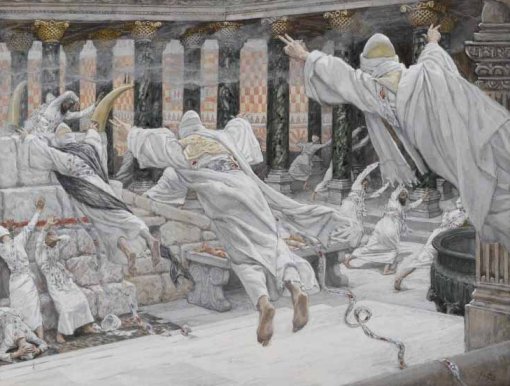 The first believers to rise did so right after Yah'shua in Jerusalem
The first believers to rise did so right after Yah'shua in Jerusalem
A Resurrection Foretaste of What is to Come
This was a foretaste of what will yet come to pass:
"For the Master Himself will come down from heaven, with a loud command, with the voice of the archangel and with the trumpet call of Elohim (God), and the dead in Messiah will rise first" (1 Thess.4:16, NIV).
The Cloud of Resurrected Saints
We have no idea who these believers were or how many of them were raised. Some suggest that the "cloud" that received Yah'shua (Jesus) when He ascended (Ac.1:9-11) was, in fact, those resurrected qodeshim (saints, set-apart ones) resurrected right after Yah'shua (Jesus), and that they tarried with Him for the 40 days He remained before ascending up to Heaven. This is not an unreasonable suggestion given the symbolic usage of clouds elsewhere. At the Second Coming the qodeshim (saints, set-apart ones) who are alive will be caught up together "in [the] clouds" before returning with Him to rule on the earth. Those "clouds", or at least one of them, could well be those firstfruits believers from 2,000 years before, along with the remainder of the Bride of 144,000 who are resurrected at that time, both the dead from all the aeons before as well as those alive at His appearance. Note that there is no definite article - no "the" before "clouds" in the Greek so the passage would more accurately read:
"After that, we who are still alive and are left will be caught up together with them in clouds to meet the Master in the air. And so we will be with the Master forever" (1 Thess.4:17, NIV).
A Cloud of Witnesses
How do we know 'clouds' can represent people? Because of the way 'clouds' are used in Hebrews, as in "a great cloud of witnesses" (Heb.12:1, NIV). The Book of Revelation, being highly symbolic in content, says of Yah'shua's (Jesus') second coming:
"Look, He is coming with the clouds, and every eye will see Him" (Rev.1:7, NIV).
Many Clouds at the Second Coming
Clouds, by their very vaporous nature, tend to conceal, yet every eye will see Him when He returns, so these clouds are not obscuring Him from the earth. Indeed, the clouds themselves are coming with Him from Heaven! These are, in my view, the resurrected firstborn qadoshim (saints), both those coming down from heaven and those rising up to meet their Conquering King. One of those clouds will, likely, consist of the First Messianic Bikkurim qodeshim (saints, set-apart ones)!
An Exciting Day
What an exciting day the resurrection will be! The resurrection of Yah'shua (Jesus) and the hope of the resurrection of the qadoshim (saints, set-apart ones) was the main driving force of these early believers. Those who minimise or neglect the resurrection altogether may well not have the same emunah (faith) as the first talmidim (disciples). Indeed, they hay even be representing a false gospel. Without a proper resurrection testimony our emunah (faith) is futile.
Conclusion
I am well over time and there was much more I wanted to say about the beliefs of the first believers. Hopefully another time. I pray that this will have kindled your passion and interest in the resurrection. I pray the Ruach (Spirit) will show you how you are to witness of this truth for the salvation and edification of souls. I look forward to seeing you next Sabbath and then the day after for Yom Teruah (Day of Trumpets/Shouting). Have a blessed sabbath in Yah'shua our Messiah (Jesus Christ)! Amen.
Endnotes
[1] Ridyard Kipling, When Earth's Last Picture is Painted (Hodder & Stoughton, London: 1927), pp.223ff.
[2] Dylan Thomas, Do not go gentle into that good night (1952) (New Oxford Book of Verse, OUP: 1972)
[3] Tom Wright, Surprised by Hope (SPCK, London: 2007), p.55
[4] Op.cit, p.56
[5] See, for example, Sir Norman Anderson, Jesus Christ: The Witness of History (Intervarsity Press, Leicester, England: 1985) and Lee Strobel, The Case for Christ: A Journalist's Personal Investigation of the Evidence for Jesus (Zondervan, Grand Rapids, Michigan: 1998)


|


